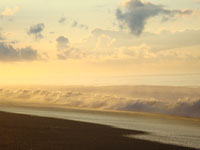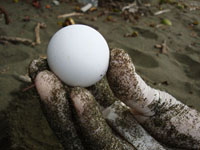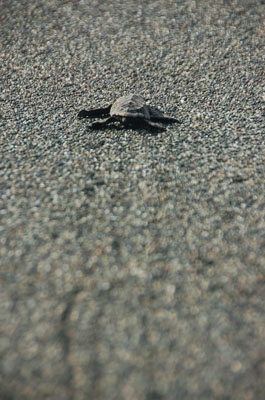 Morning breaks, an explosion of pastel paints splashing up from the dark horizon. Within minutes low-slung clouds are trimmed in gold leaf and violet water licks the beach. Manuel and I have just arrived at the shore, emerged from the dense green understory in perfect time to catch this glorious sunrise.
Morning breaks, an explosion of pastel paints splashing up from the dark horizon. Within minutes low-slung clouds are trimmed in gold leaf and violet water licks the beach. Manuel and I have just arrived at the shore, emerged from the dense green understory in perfect time to catch this glorious sunrise.
Twenty-five minutes of rainforest prevails between our camp and the coast. We navigate a familiar trail every night, and every morning. Winding between trees, ducking under vines, shuffling down muddy slopes and across shallow rivers, we move in a tunnel of leaves and shadows until, at last, we are coughed out onto the beach facing 10,000 miles of water.
As the sun arcs up and pelicans pass overhead, we begin walking. The A.M. job is to check all the marked nests along this five kilometer section of coastline and we chatter in Spanish as we amble from one yellow tag to the next. Generally speaking, Manuel and I are looking for three things:
1. NEW NESTS: Nests that were dug in the wee hours after Night Patrol while we were asleep in our bunks. Upon finding fresh tracks, we follow them to the nest for measurements and evaluation.
2. DEPREDATED NESTS: Depredated means the nests have had some of their eggs dug up and/or eaten. These are often unmarked nests. (Remember, marked nests are covered with squares of metal fencing to discourage digging predators like coatis and raccoons—the protection is not perfect but it works quite well.)
At depredated nests, we clean up any exposed eggshells, counting them and logging the loss in our field notebook. We also dig down into the nest to ensure there are no broken or half-eaten eggs, which could foster an infestation of maggots or lure crabs with their rotting smell. When the nest is properly tidied and sand has been carefully repacked over the remaining eggs, we move on.

 3. HATCHED-OUT NESTS: Nests that have hatched-out are easily identified by dozens of tiny tracks squiggling toward the frothy tide. Held in the quiet safety of their sandy maternity ward, baby sea turtles may hatch out at different times over a period of 1-4 days, but they wait to surface together so they can shuttle into the ocean under safety of the group. Old nests must be cleaned out to collect as much data as possible, so the screen is rolled back and the hole thoroughly excavated.
3. HATCHED-OUT NESTS: Nests that have hatched-out are easily identified by dozens of tiny tracks squiggling toward the frothy tide. Held in the quiet safety of their sandy maternity ward, baby sea turtles may hatch out at different times over a period of 1-4 days, but they wait to surface together so they can shuttle into the ocean under safety of the group. Old nests must be cleaned out to collect as much data as possible, so the screen is rolled back and the hole thoroughly excavated.
Today we discover a freshly hatched-out nest. I am disappointed that we missed the dashing slew of green bodies. Opening the nest, I begin hauling up curls of white leathery shell while Manuel pencils the findings. We count all the empty eggshells to see how many turtlings hatched and left the nest. We also examine any un-hatched eggs, tearing them open to determine at what stage life failed. Was the egg fertile? If yes, when did development stop? These details are scratched onto spiral-bound paper for future analysis by Friends of the Osa.

 I dig slowly, methodically. I find one round egg, pristine. Inside, it still holds a perfect yellow yolk but no sign of life. A dud. Another egg is already torn and reveals a near-term baby covered in small fly larva.
I dig slowly, methodically. I find one round egg, pristine. Inside, it still holds a perfect yellow yolk but no sign of life. A dud. Another egg is already torn and reveals a near-term baby covered in small fly larva.
In the next scoop I feel a few ounces of supple flesh, which placidly stirs in my hand. A straggler, an infant still buried in the chamber. He is alive but extremely weak and looks misshapen. I dust off his crumpled body and set him on the sand to see what he does. Nothing. Still. Utterly motionless. Perhaps he just died.
I sigh and turn away from the sad sight to continue my task of shoveling, counting, but several minutes later Manuel points out that the baby is moving, wiggling its little flippers and head. We stop our efforts to watch his, feeling a surge of foolish hope.
 Minutes tick by. The tot is in no rush but does seem to be building energy, a tiny balloon inflating with life. When he begins his natural march to the sea, he moves only millimeters at first, but finds speed and enthusiasm as he paddles. Our hope gains confidence. It’s a long distance to the water’s edge. We would do him no service to make the journey shorter—he needs this time to rev his engines, gather his wits—so we simply stand there, watching, guarding against birds with a taste for turtle.
Minutes tick by. The tot is in no rush but does seem to be building energy, a tiny balloon inflating with life. When he begins his natural march to the sea, he moves only millimeters at first, but finds speed and enthusiasm as he paddles. Our hope gains confidence. It’s a long distance to the water’s edge. We would do him no service to make the journey shorter—he needs this time to rev his engines, gather his wits—so we simply stand there, watching, guarding against birds with a taste for turtle.
His commitment grows. Half way down the beach he is springing forward with vitality, as enthusiastic and powerful as any hatchling I’ve seen before him. He nears the lacy foam with brave zeal and we cheer silently, thrilled by his intense commitment to do what baby turtles do. As the next surge sweeps up and touches him, he instinctively paddles harder and faster to catch its lift. The surf wraps around his minuscule frame and gathers him up in a powerful embrace, like a loving grandfather who has been waiting a lifetime to see him.
The turtling dives for a minute—we, too, hold our breath.
But then we see him working his way past the breakers. We point and laugh with the giddiness of children as we spot his bitsy head bobbing above the cerulean waves. He has made it to the sea! If only he can string such moments of survival into an 80-year lifespan. This, we know, is the last we will see of him and I whisper farewell as he disappears into the pelagic swirl.
It is a blessing and an honor to walk this beach twice every day. To observe nature’s complexities, stand witness to its magnificence and, most profoundly, find my own place in its workings. Night Patrol is all reverence and mystery; we are strangers tiptoeing in the darkness. But Morning Patrol is about seeing the world in detail, a time when life’s magic is exposed in the glorious light of the rising sun.

